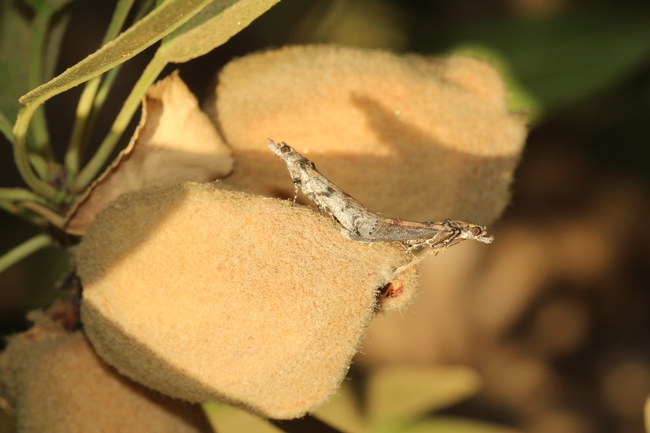As a result of UC ANR's Almond Pest Management Alliance Project, use of mating disruption as an ecologically sustainable pest management practice tripled over two years by growers and pest control advisers who influence over 400,000 acres of almonds in the San Joaquin Valley.
The Issue
Navel orangeworm is the single most important pest of more than 1.3 million acres of almonds in California. It feeds exclusively on almond kernels, rendering them unmarketable. Larvae are also associated with Aspergillus sp. fungi which can produce aflatoxin contamination of kernels at harvest. Control of navel orangeworm is essential to prevent yield losses, off-graded kernels, and kernel contamination.
How UC Delivers
For the past three years, UC ANR Integrated Pest Management (IPM) Advisors David Haviland, Jhalendra Rijal, and Emily Symmes demonstrated an innovative new approach to worm management called mating disruption to more than 16,000 farmers at more than 120 conferences in 36 cities and 20 counties. This technique is done by releasing large quantities of a chemical pheromone used by female moths to attract males. This disorients males and substantially impairs their ability to locate a mate, leading to reduced offspring. Eight demonstration orchards were established across the San Joaquin and Sacramento Valleys as part of an Almond Pest Management Alliance grant in conjunction with the California Department of Pesticide Regulation, almond farmers, pest control advisers, and the Almond Board of California.
The Impact
More than 93% of participants in the Almond Pest Management Alliance Project stated that information that they received was considered when making pest management decisions, with 81.4% reporting that they changed their practices because of what they learned. In the southern San Joaquin Valley, pest control advisers reported increases in the percentage of their acreage using mating disruption from 16.3% in 2017 to 39.0% in 2019 and, in the northern San Joaquin Valley, from 6.5% in 2017 to 37.7% in 2019. These growers and advisers influence over 400,000 acres of almonds.
Mating disruption is agriculturally efficient and profitable because, at harvest, there was a 47.4% reduction in navel orangeworm damage on average across all participating orchards over two years. This increased crop value by more than $250 per acre, which is more than twice the cost of employing this novel management technique.
In addition, the pheremone-based approach is more sustainable because it reduces reliance on pesticides, reducing groundwater contamination and avoiding resistance problems for pests and diseases, respectively. Recent pesticide use reporting data for Kern County underscored these changes in practice, showing a 26% countywide increase in the adoption of mating disruption from 2017-2018 on the more than 200,000 acres bearing almonds in the county.
In this way, UC ANR increases agricultural efficiency, profitability, and ecological sustainability, contributing to the public values of promoting economic prosperity in California and protecting California's natural resources.


